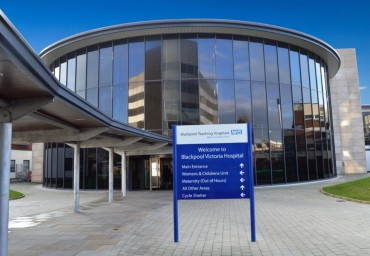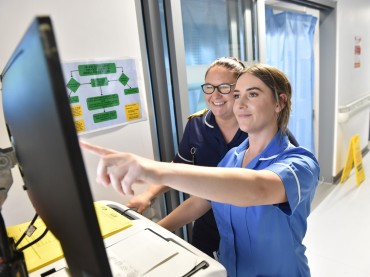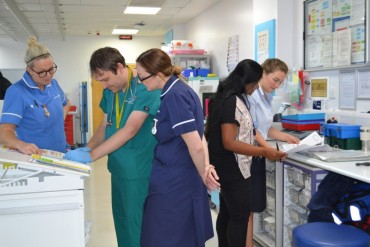Contents
Tests you may have had........................................................ 3
What Treatment/Monitoring is there for the Fluid Build Up?.. 4
What can I do to help?........................................................... 4
How can I monitor my ascites?.............................................. 4
Weight and Abdominal Girth Chart.....................................5-6
Diet........................................................................................ 7
No added salt diet.................................................................. 7
What medications we could use to help you ......................... 8
Things to be aware of...........................................................10
Have you any questions?......................................................10
Gastroenterology & Endoscopy Unit Location Map..............11
Ascites is the medical term given to the build up of fluid in the tummy between the organs and the wall of the tummy. The fluid can build up
steadily over a few weeks or develop quite quickly over a few days.
What causes this?
Most commonly this is caused by cirrhosis of the liver. Cirrhosis is a
long term condition that is caused by scarring of the liver.
What are the symptoms?
• Fluid in the tummy can cause a swollen tummy that can become painful
• Weight gain
• Breathlessness
• Unable to eat full meals
Sometimes the fluid in the tummy can become infected which can cause worsening tummy pain and high temperature. You can
become a little confused. If you experienced these symptoms you should visit your doctor right away.
Ultrasound scan
This looks at your liver and can look for fluid in the tummy.
Diagnostic Tap
This is where a sample of the tummy fluid is taken (after the skin
is numbed using a needle and syringe). This fluid will be sent to
the laboratory to be tested for any infection. If the test comes back
positive you will need antibiotics.
Paracentesis – or ascitic drain
This is where the skin is numbed on the left side of the stomach.
A tube is then inserted to drain the fluid that has collected inside the tummy in order to ease the symptoms. Drainage can be anything
from 2 litres to 15 litres!
Diuretics – (water tablets)
You may be prescribed these to help prevent / control the fluid build up. This tablet can make you pass more urine than normal. You will
need your bloods checking regularly whilst on this medication (see page 9).
Paracentesis
Where the fluid is drained from the abdomen over a period of
6–8 hours, (see page 2).
• Follow no added salt diet (see diet section)
• Daily weights and abdominal girth measurements
We would like you to help monitor your condition so we can give you the best care. There are several things we want you to do.
Daily Weight
• Complete chart on page 4 and 5
• Weigh at the same time daily
• Use the same set of scales
• If you put on 4kg (approximately 9 pounds) you should contact us
Your weight should remain steady. If you start to put on weight it may indicate you are building up fluid again.
Nutrition is important when you have liver disease. Food gives the
body energy.
Eat healthy meals where possible. If you cannot manage large
meals, eat small snacks often throughout the day and evening. This
will help to give the body the energy it needs.
Sodium, or salt, is the main ingredient in table salt. It is also found in
lots of food.
Although the body does need a certain amount of sodium to work
normally, most people eat more salt than they need.
Checking the label is the best way to see the amount of sodium in
the food you are eating.
What foods contain the most sodium?
Processed foods contain high amounts of sodium. These usually
come in cans, packets, jars. Examples of high sodium foods:
crisps, pot noodles, ready meals, salted, peanuts.
Water tablets (diuretics)
These are medications that get rid of excess fluid in the body.
Spironolactone
Spironolactone is a known as a water tablet or a diuretic.
Spironolactone is the usual, initial choice of tablet for patients with
cirrhosis. It helps remove fluid that may build up in the tummy.
50mg a day can gradually be increased to 400mg if it is needed.
Furosemide
Furosemide is also known as a water tablet or a diuretic.
Furosemide may be used with spironolactone, depending on how
effective spironolactone is on its own.
Most people will start with a low dose and increase until some of the
body’s fluid levels are controlled and the fluid doesn’t build up.
Blood tests
You will need to have regular blood tests to check the effect the
water tablets (diuretic) are having on your body, particularly the
kidneys and the body’s sodium and potassium levels.
Sometimes the diuretics may need to be stopped if your blood
results change too much, although they may be restarted again at a
future date. The practitioner looking after you will make this decision.
Laxatives
People with cirrhosis can sometimes develop problems with their
brain function (Hepatic Encephalopathy).
Hepatic encephalopathy can be experienced in liver disease. It
can cause changes in thinking, behaviour, and personality. This is
caused by a build-up of toxins in the brain of people who have liver
disease. This is because the liver is not working as it should by
getting rid of the body’s waste products. You can feel sluggish and
forgetful and other people may notice you are not yourself.
Lactulose
The main treatment for encephalopathy is lactulose syrup. This acts
as a laxative (it helps clear the bowels) and helps remove the toxins
that build up in the body when the liver is not working properly. In
some cases, other laxatives or an enema may be used.
Lactulose doses can be managed by you as long as your bowel
movements are at least twice a day. For example, you may need to
take an extra dose if you are not having your bowels opened twice
daily or omit a dose if you find you are having loose stools.
Antibiotics
Rifaximin
Rifaximin is in a class of medications called antibiotics that are used
to prevent episodes of Hepatic Encephalopathy.
Rifaximin treats hepatic encephalopathy by stopping the growth of
bacteria that produce toxins and that may worsen liver disease.
Seek medical advice/attention for example: the G.P., Walk in Centre,
Nurse Led Ascites Management Team or Accident and Emergency.
• Tenderness/pain in your tummy
• Any bleeding when you open your bowels
• Vomiting dark fluid or blood
• Increased yellow colour to the skin or in the eyes
• Increased confusion
• Increased thirst
• Increased breathlessness
You may find some helpful information in one of the sources below:
• British Liver Trust
www.britishlivertrust.org.uk
• Alcohol Anonymous (A.A.)
www.alcoholics-anonymous.org.uk
• Local community alcohol support groups
(see local directory for details or ask the Nurse Led Ascites
Management Team)
Please write down any questions you have below or anything you
want to discuss with us.
Access from the main hospital multistorey car park
We are located in Area 6 - Gastroenterology & Endoscopy Unit,
highlighted in orange on the main hospital map. Follow the signs for the
Main Hospital up the escalator/lift towards Area 6, second corridor on the
left. Follow the signs down the link corridor, exit to the right via the side
door (external) which is signposted for Patient Entrance to Reception.
Access for drop off/collection only & disability parking
Enter via East Park Drive and follow the road up the hill, take the
second left signposted for Gastroenterology & Endoscopy Unit Drop
Off Only, follow the road round to the right.



